
I’ve seen many interesting city meetings over the years, but nothing quite like what transpired last night on the corner of NE 7th and Tillamook.
The Portland Bureau of Transportation was supposed to break ground two days ago on a project to remove the traffic circle at this intersection as part of a larger neighborhood greenway project. But when they sent the construction notice to nearby residents, many folks didn’t like the plan. And that’s putting it lightly.
The opposition was strong and well-organized enough that PBOT agreed to meet with neighbors Wednesday night. And it happened right in the street. Since the street is closed to cars for the imminent construction, it was quiet and calm. It also turned out that the crowd was so big they needed all the space they could get. I counted over 60 people at one point. They walked from their living rooms, and they rolled right up on their bikes.
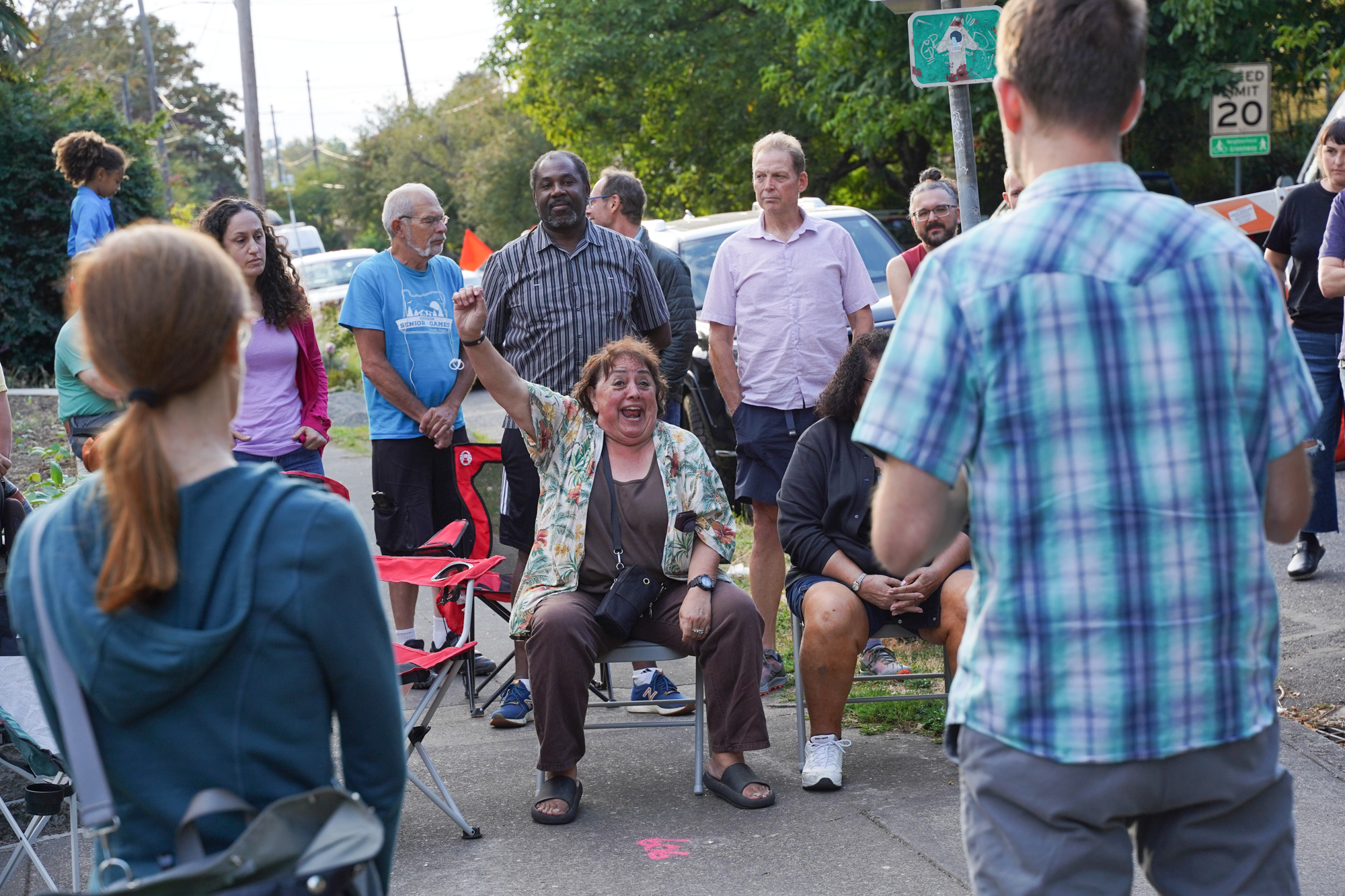


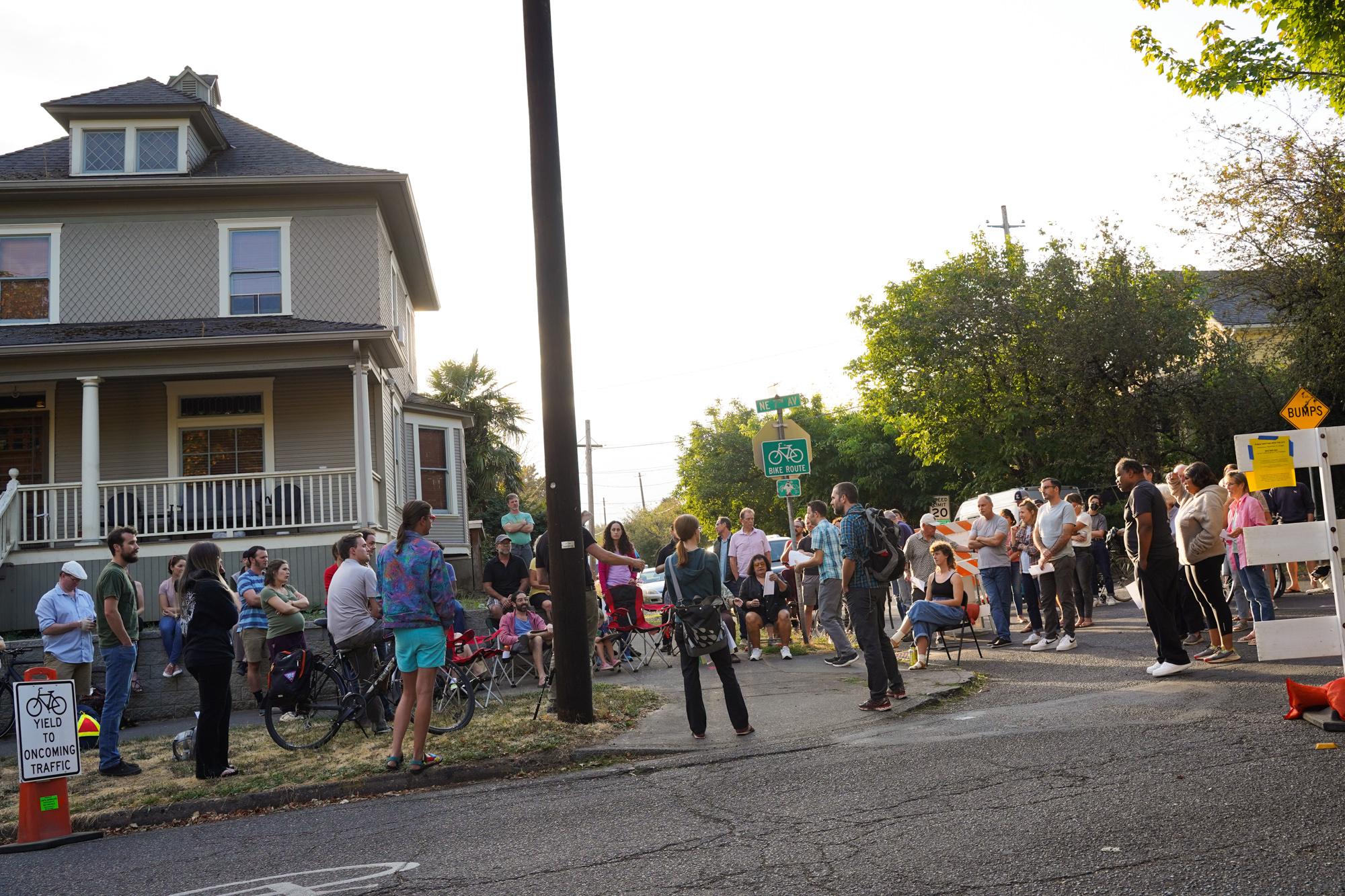

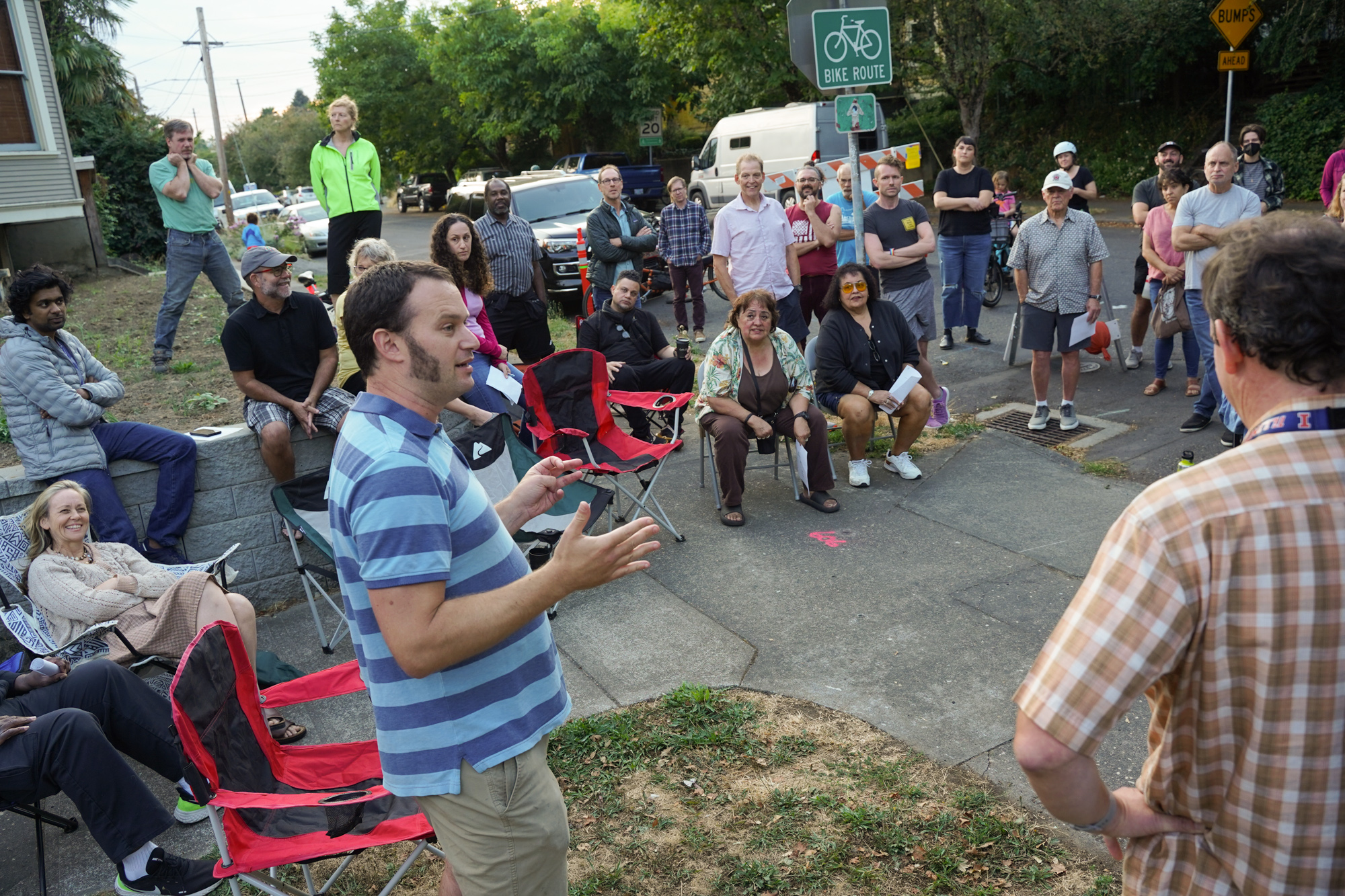

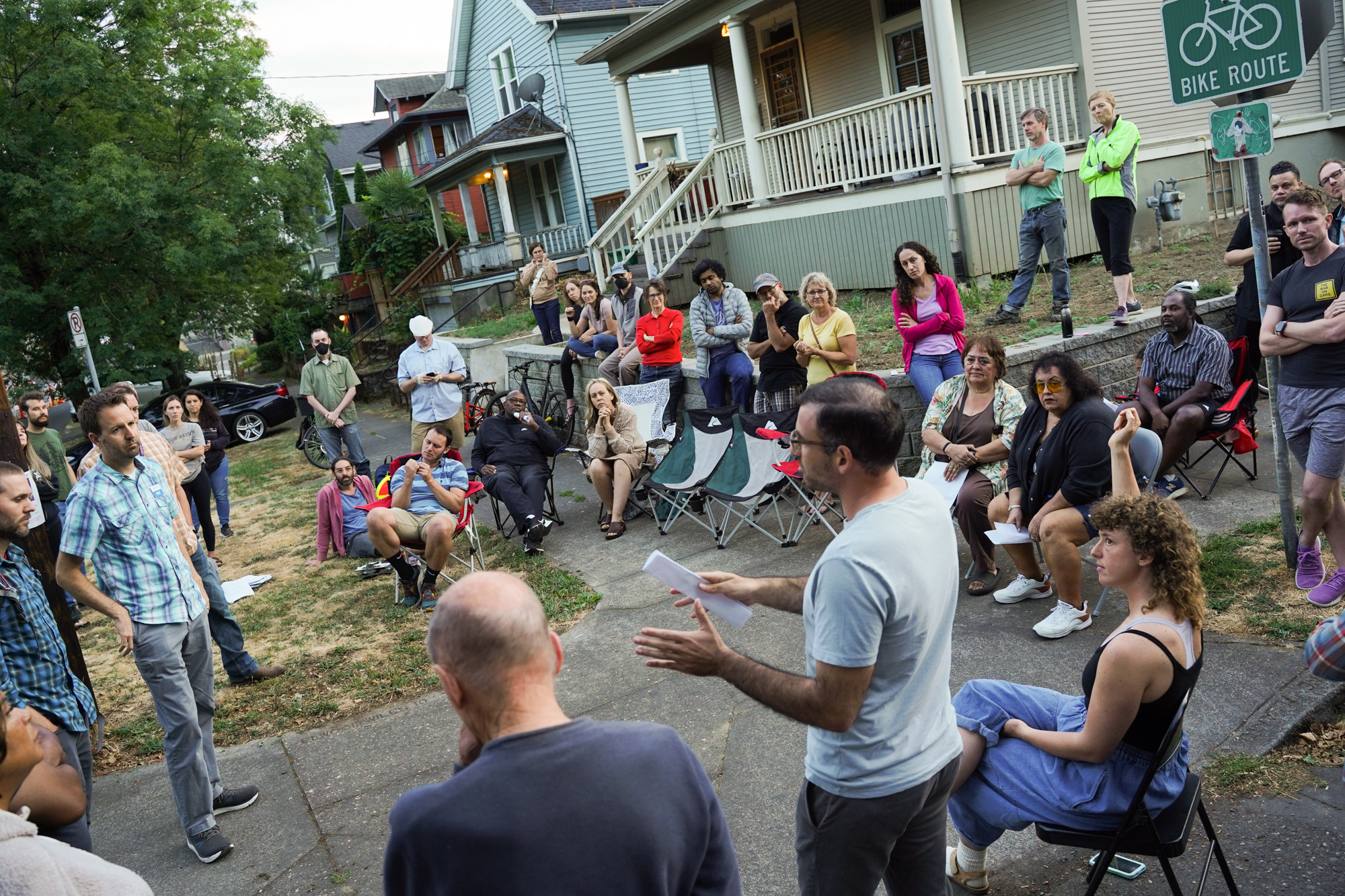
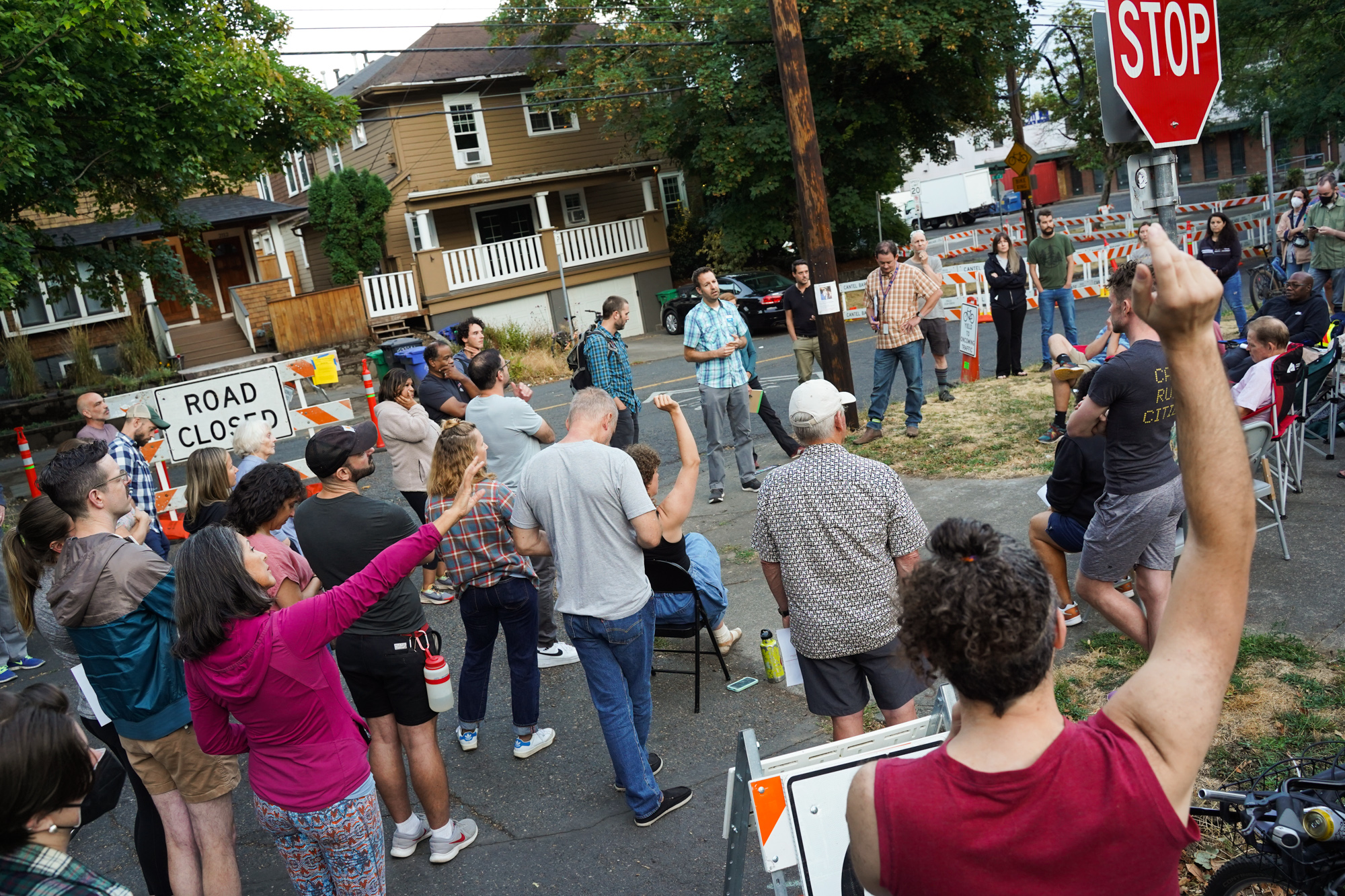

There were six PBOT staff in attendance (five of which appeared to be on the clock) led by Capital Delivery Division Manager Steve Szigethy. Szigethy and his team — Nicole Pierce, project manager; Nick Falbo, planner; Anthony Buczek, engineer; and Andrew Sullivan, engineer — had to navigate a thorny thicket of issues. As I shared yesterday, the initial public outreach on this project was not only four long years ago, it was also framed with the complex issues of racial discrimination and gentrification in inner north and northeast Portland.
As if that wasn’t challenging enough, the gap between the conclusion of the public process in 2018 and the start of construction today, meant that most people who live near 7th and Tillamook were caught off guard. Right off the bat, Szigethy apologized for the delay. But that wasn’t the only gripe from neighbors. Most people in the crowd simply didn’t like PBOT’s proposal — which for some reason wasn’t made public until the day construction was supposed to start.
The proposal to remove a traffic circle (and large tree in the middle of it) in order to improve safety just doesn’t square with most people. We heard many horror stories from folks last night about dangerous and reckless driving at the intersection. One couple said they won’t let their young child play in the front yard, another guy dropped a broken license plate at the feet of a PBOT staffer and said it’s one of many that’s been knocked off his parked cars after being hit by drivers. Another person said they don’t know their neighbors because the traffic is so stressful no one sits on their porch.
Rose Francis, the woman who organized the neighborly uprising, said she recently saw two middle school kids nearly get hit while biking to school.
Francis read out her concerns from a pre-written speech:
“Cars drive aggressively through this intersection, honking and cussing at cyclists and residents as we try to cross the road or back out of our driveways. Speeding is a huge problem. If you remove the circles, speeds are going to go up. A Black boy was hit and killed on this street by a speeding car 50 years ago. There is a history of neglect in this community. Removing the traffic circle without putting real protective measures in its place, puts our community members at grave risk.
It appears PBOT is not doing enough to protect this neighborhood because it is more convenient for some people living to the north to use 7th Ave as an alternative thoroughfare to MLK which is one block over. That is improperly balancing the convenience for people outside this neighborhood against the life and safety of people inside this neighborhood.”
Many people at the meeting echoed Francis. “Signs and lines are not going to do it,” one person said.
Not everyone was mad at PBOT. Several folks spoke up to say they’re eager to rip out the traffic circle. “I want this thing gone!” yelled one woman. “It’s unsafe! They’re making a good choice.”
But opposers outweighed supporters, so PBOT’s task last night was to defend their proposal. Why? They’ve already hired a contractor who’s just sitting on their hands waiting to break ground. In PBOT’s mind the plan is set and this thing needs to get built. A resident revolt was completely unexpected.
“This traffic circle does improve conditions for some folks crossing the street. But it also makes it less safe.”
– Nick Falbo, PBOT
Right now, NE 7th has about 4,000 to 6,000 cars on it per day. PBOT’s dream is to get that down to 1,000 or less. In the meantime, since two neighborhood greenways come together at NE 7th and Tillamook, and it’s a key connection to the new Blumenauer Bridge, PBOT wants to give bike riders the option of riding in dedicated bike lanes without sharing space with drivers. The only way to fit four travel lanes (two 10-foot wide general lanes and two bike lanes), they say, is to remove the circle.
In addition to needing space, PBOT said traffic circle intersections like this one have more crashes on average and they can introduce unpredictable behaviors because many people (including bike riders) will cut through it in the wrong direction. At this location specifically, visibility is bad because of the circle’s vegetation and the grade of the road.
“This traffic circle does improve conditions for some folks crossing the street,” PBOT Planner Nick Falbo said last night, before sharing copies of their new design proposal. “But it also makes it less safe. We think what we’re creating is a design that can maintain safe crossing and can improve conditions on a net level for people trying to navigate this area.”
It’s important to keep in mind that the removal of this traffic circle was initially part of the much more dramatic PBOT plan to put the neighborhood on greenway on 7th. In 2018, PBOT released a plan that would have transformed 7th into a quiet and calm street; but several major community organizations that serve Black Portlanders (church, housing developer, business association, a Head Start program) opposed it. “We got feedback [in 2018] that the plan would not be good for the families those organizations serve,” Falbo recounted, “And it was not something we were going to pushback on.”
So PBOT decided to switch the greenway route to NE 9th and only do minor traffic calming on 7th.
Fast forward to last night and a different subset of neighbors are now upset with PBOT for not pushing forward with that initial plan. One woman who was also involved back in 2018 (and whose name I didn’t get), put it this way:
“I feel like what’s happened is there was a really genuine concern from the African American communities up north and I think that’s important; but there’s no organization here. We’re just people living here. People work late. They don’t have the bandwidth to come out.
The thing is, we need a greenway, we need what you originally conceived of [in 2018]. It’s brilliant. It’s exactly what we need. People come through here, they try to run me over. It’s crazy! No one ‘s sitting out on their front porch because it’s a highway and it feels terrible. This barrier [the current closure and barricades] has been so amazing. People have been out walking more. This is your opportunity to really help us feel more like a community. To be able to feel each other and not just like we’re trying to hide out in our backyards.”
By the end of the meeting it became clear that diversion and traffic calming is what a lot of people really want.
After listening and talking for well over an hour, PBOT’s Szigethy was ready to make a deal. He laid out a three-part plan and asked for support. The proposal was to:
- Allow PBOT to move forward immediately on their redesign plan and remove the traffic circle.
- PBOT will come back to the neighborhood with a plan to add more calming features like speed bumps, concrete planter diverters, and so on.
- PBOT will agree to revisit some of the decisions about the greenway plan for 7th that were shelved in 2018.
Initially folks rejected the proposal because they didn’t trust that PBOT would return with those additional calming elements. At first, Szigethy said they don’t have time for the back-and-forth and must get started right away. But sensing a breakthrough, he ultimately relented and an agreement was reached: PBOT will send neighbors a new plan by this Friday and they’ll have until Monday to sign off on it. (Someone collected names and emails of all in attendance.)
A lot has changed since 2018. PBOT is much more nimble with diversion these days because of all the slow streets and plazas they installed during the pandemic. And it feels like most Portlanders are more open to diversion and traffic calming than in the past. With traffic volumes going down and more people walking and being outside in their neighborhoods, they’ve seen the positive impacts of less car use.
Will this change in public will translate into political will? Will PBOT’s proposal satisfy this group? Will PBOT be willing to dust off that amazing 2018 greenway plan for 7th and restart talks with Black community groups who opposed it?
Stay tuned.
UPDATE, 6:05 pm: PBOT has released the revised plan to the neighborhood group. Looks like two speed bumps and one concrete planter barricade:



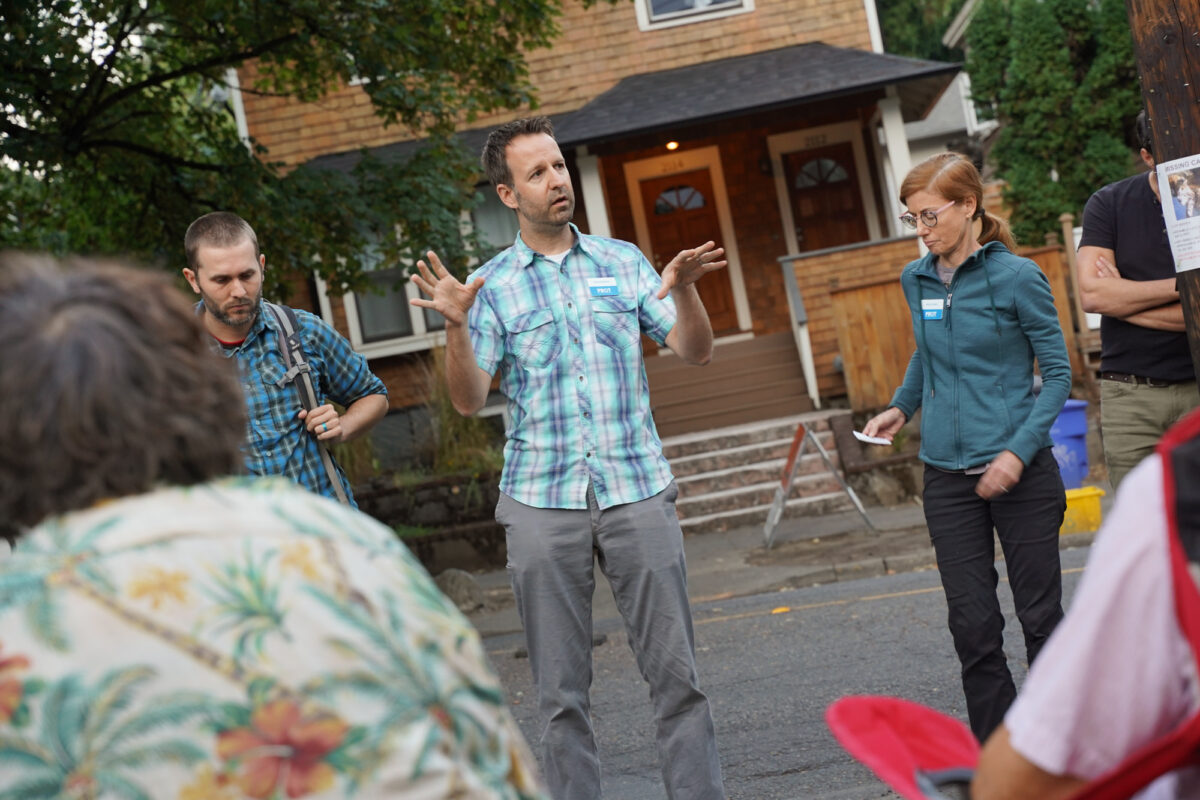
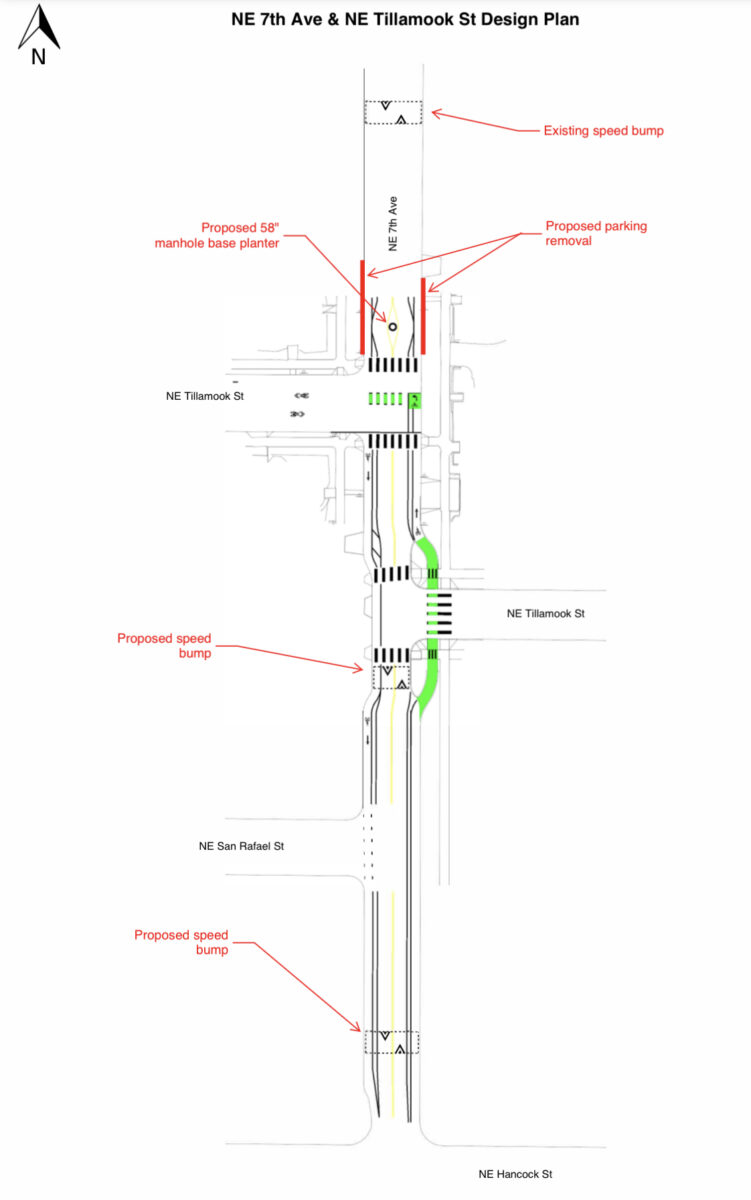
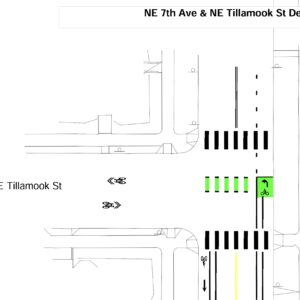
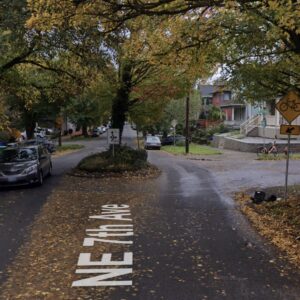

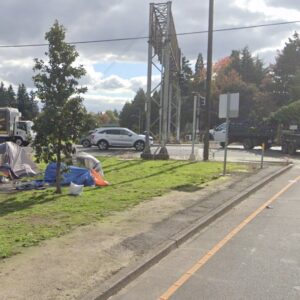
Thanks for reading.
BikePortland has served this community with independent community journalism since 2005. We rely on subscriptions from readers like you to survive. Your financial support is vital in keeping this valuable resource alive and well.
Please subscribe today to strengthen and expand our work.
Thanks for your excellent coverage of this important issue for the Portland biking and local communities.
It was encouraging to hear the general consensus (including by PBOT) yesterday that the root cause of the safety issues on 7th was the excessive volume of cars rather than a specific roundabout.
PBOT also acknowledged that after the greenway project failed, they never revisited the issue of mitigating traffic on 7th as a standalone project. I wonder if their current plans were discussed with the public back in 2018 or if it was presented as an either/or with the 9th street greenway, with the alternative plans for 7th never really being discussed — until now. The residents all seemed surprised.
Now seems like the time to have a full conversation about bringing 7th back to its intended levels of traffic as a local-only street. 7th has the potential to be a key bike artery linking several of the most diverse and vibrant neighborhoods in the city on a safe, well-paved road that ends with a brand new $19 million bridge.
And, now that 7th is temporarily closed at Tillamook, PBOT can get real world data about whether the concerns that led to cancelling the greenway even materialize– limited access to certain businesses/organizations and diverting traffic to neighboring streets. Has PBOT considered installing temporary diverters at this intersection then studying the effects on the community as part of a larger conversation about how to mitigate traffic on 7th?
I think temporary diverters would be a great way to understand the real-life issues with diversion. The key is to always always always remove them after the pilot while the decision making process is underway. That will give opponents some reassurance that a “test” isn’t just a sneaky way to make changes without proper process.
Trust is everything.
I just want to second Randy on Jonathan’s excellent reporting on this topic. I did not find anything about this proposed change on PBOT’s website, and would not have learned about it without bikeportland. This article is also even handed and considers both the perspective of PBOT and residents. Thank you, Jonathan and bikeportland!
It’s great to see that many people standing in that intersection. I always try to get through it as quick as I can to avoid issues with speeding cars. It’s amazing how much a street can change when you close it to cars, now PBOT should keep it like that!
I was there last night- I don’t live precisely at the intersection but a few blocks away and I bike it all the time. The neighborhood opposition to the removal of this specific traffic circle is inconsistent at best. They want safer ped crossings for their children, but somehow a giant mass of brush in the middle of an intersection with uncontrolled parking and unmarked crossings is safer than the proposed well-marked crossings with clear sightlines. They’re anti-car and pro-cyclist, but cyclists are also mowing down their children and making it too hard for them to back out of their driveways. They want stop signs (which the engineers repeatedly stated are not indicated by the data and would be in violation of federal traffic safety regulations) but also admit that the stop signs that are just a few blocks south on 7th don’t work at all.
The neighbors are not unified in their take on the situation and there was no clear solution presented (aside from ‘add diverters’ which is not going to happen to a lone intersection outside of a greenway project- it would just push the cut-through traffic one block north). It’s obvious that they are using this traffic circle as a political pawn to try to get the 7th Avenue greenway back. Of course I want the 7th Avenue greenway too! Many, many people do, but it was scrapped for reasons well-documented elsewhere. Fighting over this traffic circle isn’t going to make it happen- the greenway is going on 9th. Let’s not let perfect be the enemy of the good.
I thought it was clear that everyone though there was too much car traffic on 7th; the danger of the roundabout was just a side effect of that. 7th is meant to be a local street but it’s handling 6,000 cars a day. It’s never going to be safe for bikers and pedestrians with that kind of volume.
Diverters or other traffic mitigation on 7th would make 7th and 9th viable bike streets. There is no reason that both shouldn’t be safe, neighborhood streets when MLK is one block west of 7th; this doesn’t have to be an either/or, and the plans already call for far less traffic on 7th without any changes whatsoever. That was the concern I heard last night.
Yes, there’s too much car traffic on 7th. This particular traffic circle’s existence does not meaningfully impact the amount of car traffic. Also you can’t just plop down some diverters in one spot, it would be a systemic change for the whole street which requires a design and construction process. I assume the resources to do that were shifted to the 9th Avenue project after the 7th Ave project was effectively killed. I’m in favor of reviving the 7th Ave project, but that will take political will and months/years. Meanwhile, we could improve this intersection right now- the money is there and the contractors are literally sitting on their thumbs.
Some diverters were plopped down on Clinton and Lincoln/Harrison with no additional changes and they’ve done wonders.
Putting a diverter at Hancock and one at Knott would result in major traffic improvements for 7th. People are going to be biking up and down 7th anyway, most likely more than 9th will ever be used so why not make it safer in easy ways such as this?
Taking out a physical structure that impedes the speed of vehicles traveling down seventh does not improve the intersection, it allows for cars to go faster. Faster route for cars= more cars cutting through and cyclists & pedestrians having a harder time crossing the street because cars don’t tend to volunteer to slow down when they don’t have to. The trees could be trimmed to improve visibility. Or stop signs could be utilized as they are generously throughout the Irvington neighborhood where you live. Diverters absolutely can be plopped down as a trial and drivers will adjust and no one’s lives will be in danger! Removing the traffic circle (or trimming the foiliage) and adding diverters still gets the contracter business (which is apparently a huge priority) and solves the problem! A true greenway would be much better but the latter is a suitable compromise.
My point is that the tree presents more danger as-is by impeding sightlines for pedestrians and causing cars to race cyclists and merge into them than it mitigates by slowing cars down. Also they clearly stated at the meeting that stop signs are not an option due to engineering regulations- if you want to argue that point, take it up with the engineers. I definitely don’t care if the contractor gets business, my point there was that the proposed changes can happen *immediately* and any non-proposed changes will not happen immediately.
I’m not at all anti-diverters, I’m just pro- things happening. A 7th Ave mini-greenway sounds great in theory (seriously, I’d use it all the time) but the reality is that it cannot continue towards Fremont because of neighborhood opposition in that area (plenty of Bikeportland coverage about that on this site). Doglegs in greenways make people way less likely to use them, and a halfway 7th greenway doesn’t make sense. Take it up with your northern neighbors!
Second this except for the part about stop signs. Stop signs are an admission of failure to design the street properly in the first place.
I agree with much of what you are saying, except that plopping down some diverters near popular starting points for cutting through seems like an okay thing to try out, and exactly what PBOT did do during the pandemic. A diverter south of Tillamook on NE 7th would make cutting through from Broadway much less attractive and likely would push drivers to go all the way to MLK to go north. While those folks could then cut back into the neighborhood in other places, that one diverter could accomplish quite a bit — and perhaps not interfere with drivers accessing Head Start and such a handful of blocks north.
Second this comment Joan! It would take one diverter to remove 7th as a cut through for avoiding MLK, which would return the street to the local traffic it was designed to carry.
*citation needed*
Someone at the meeting said it, not me
*citation **still** needed*
Is the greenway going on 9th? It’s 4 years later and literally nothing has been done on 9th.
yes, that is the current plan. Nothing has really happened yet because 1) Irving Park is a massive gap that screws up the entire alignment and is a big reason many people didn’t want it on 9th. 2) 9th is already very calm and chill so PBOT doesn’t have much urgency to do anything to it. and maybe 3) PBOT is dragging feet on implementation of 9th because they know it’s a terrible compromise and they’re holding out hope that the community comes around to doing it on 7th.
As always, fascinating reporting!
Regarding this:
The touchy thing here is that “the community” isn’t the people who came to that meeting in the street. The “community” is also not the people and organizations who opposed the greenway on 7th back in 2018.
It’s hard to know what “the community” wants because most people don’t have the time or interest to come to meetings or fill out surveys, or call PBOT on the phone to set up meetings. Organizations with an interest (such as parking lot access, or correcting a history of racist marginalization) will often have an outsized impact, in part because they represent larger numbers of people (who in turn, probably don’t personally care enough to go to meetings themselves).
I personally think that it makes sense for PBOT to make 7th a Greenway, and it sounds like there’s at least some support for it (especially among the mostly white people at the meeting). It’s a bummer that it was shot down in 2018.
Keeping majority Black neighborhoods unsafe doesn’t make any sense from an equity perspective. It didn’t make sense in 2018, and it doesn’t make any sense, now.
I was also at the meeting. There were diverse perspectives from neighbors, some with ideas that didn’t mesh with each other, but a clear consensus emerged: drivers speed dangerously on 7th in volumes far above the design and plan for the street. Even those in support of PBOT’s plan, and PBOT themselves, can’t point to anything that will prevent speeds from increasing as a result of this project. All the mitigations in the design are directed at improving visibility and mode separation. Nothing in the design will mitigate drivers speeding and it’s therefore not the clear cut “net improvement in safety” that PBOT claims it is. The neighbors are united in their concern about speeds for good reason. Speed kills.
Yes, at no point did PBOT make any claims that this would reduce traffic volumes. Removing the center stripe, narrowing car lanes by adding bike lanes, and prominently marking crosswalks all have traffic-slowing effects. No, of course none of that has the same utility as physically preventing cars from entering the street with diverters, but the idea of diverters got scrapped when the 7th Ave greenway project was halted by neighborhood opposition (see related coverage on this site).
My understanding is that the car lanes in the proposed design are wider than the existing shared lane on the street with the traffic circle. And the engineer said the crosswalks and cross-bike improve visibility, not speed. There is also a center stripe in the proposed design. So nothing in the proposed design will mitigate speed.
OK, somebody already asked for a citation. Putting in “mown down by cyclists” was a pretty big counter-factual statement. Any time a bike-ped crash results in a death it’s national news. Car-ped crashes? Just a Tuesday.
In my humble opinion, they should have greenways on both 7th & 9th. The more greenways, the better! Uh, but definitely if they are tearing out that traffic circle and intend cyclists to make a left turn across 7th, they should obviously put a speed bump uphill of that left turn and should probably have budgeted to do so as part of the reconfiguration from the get go.
I am also curious about how exactly it is the case that PBOT is performing outreach to some of these communities (and how they are deciding not to move forward with safety improvements as a result of that failure), just because obviously black neighborhoods deserve to have safe infrastructure too, and it seems like that is not actually happening at least in part because PBOT’s outreach is ineffective?
It’s a bit more complicated. Black neighbors in Eliot asked for infrastructure and safety improvements in many places around the neighborhood for years and didn’t get it, and then many were quite frustrated when the infrastructure improvements seemed targeted at and driven by white gentrifers, especially bike folks. There was one intersection that many kids crossed regularly to get to Boise-Eliot School that was a known high-crash intersection, and it didn’t get a signal til New Seasons moved in (and helped pay for it). Remember this is the same Black community that was repeatedly promised all sorts of things in exchange for I5 tearing through the neighborhood, for Emmanuel Hospital gobbling up houses and land — and many of those promises were broken by the state, the city, the hospital, by everyone.
So when white folks are clamoring for infrastructure improvements that seems to be about bicycling, I get why my Black neighbors are frustrated and feeling like their concerns aren’t being prioritized. And I get why they don’t trust (mostly white) bike folks or PBOT.
I would have loved a 7th Ave Greenway, but I think PBOT made the right call in saying that they needed the support of Black neighbors to implement this. We white bike folks can’t say, “But, no, really this is good for you too.” Why should they trust us?
If we bike folks want infrastructure improvements to happen, we need to be talking to our neighbors, especially those from historically marginalized and underrepresented communities. And, we need to have conversations about what they want and need, not just what we want them to support. If you go to PBOT as a group that’s truly inclusive, it’s a lot more likely your idea and project will move ahead.
Jonathan has done an excellent job covering these issues over many years.
So I am not advocating the dismissal of black concerns, I am advocating actually effective outreach so that black communities get nice infrastructure. At this point there is fairly voluminous research supporting the idea that bike infrastructure improves road safety for all users, improves health & economic outcomes, etc. It is also the case that particularly the safety benefits would disproportionately benefit black people since they are much more likely to be vulnerable road user than white people for any given trip.
So while I understand that there has been a long history of disinvestment in black communities and that resistance to projects like this stems from that history of racism, repeated failed outreach leading to repeated failures to improve the infrastructure in black communities just compounds that history.
I would also say, as far as I know the basic idea of bike lanes = white cyclists = gentrifiers, although seemingly quite common, doesn’t actually seem to have a factual basis:
I have to be honest that, in the context of NE 7th, I have no idea what a “black concern” is. Whenever I hear anyone starting a sentence about street design with “black people want…” or “the black community feels…” I interpret whatever follows as a personal opinion that the speaker feels can’t stand on its own.
Even as a member, I don’t know what the concerns of the “white community” are, or even who the “white community” is, never mind who gets to speak for us. What are “white concerns” in the context of NE 7th? What are the Asian concerns? These questions just don’t make sense, and every time PBOT tries to answer them, they end up making decisions that have, at best, muddled results.
Do some black people want to drive fast on NE 7th? I’m sure they do. Plenty of white folks (and Asians, and Latinos, and…) do as well. I’m not sure why PBOT should care.
At the very end of the meeting, a point was raised that current plan pushes into a lane that is curb tight and does not serve bikes who want to travel west on Tillamook. Steve explained that the plan in intention of PBOT is for bikes to take the lane. When it was pointed out that providing a bike lane requires a bike to use, one of the PBOT engineers said that that rule was not enforced in Portland. It was then explained that if a cyclist is injured outside the bike lane, the driver will not be held liable because of the side-path law. Furthermore, if there is a bike lane, many drivers will expect bikes to use it, and will see a cyclist who is taking the lane as being aggressive. This design introduces more conflict between bikes and cars. PBOT said they could sharrow markings to make it clear that cyclist could use teh bike lane or the adjacent moter vehicle lane. Please be on the lookout for that in Friday’s update.
Is their a City website where this information is posted?
We’re going to design something that comes with a legal requirement to use it, but we don’t want you to use it, and no one would ever enforce it (probably… the police have done so in the past, but aren’t enforcing much these days), but to clarify the situation, we’ll add contradicting lane markers to reduce conflict.
Huh?!?
Why have the bike lane if PBOT doesn’t want riders to use it?
Cyclists are allowed to leave a right-side bike lane when preparing to execute a left turn at an intersection. The situation isn’t that unusual despite the sub-optimal design choices. See https://oregon.public.law/statutes/ors_814.420
“It was then explained that if a cyclist is injured outside the bike lane, the driver will not be held liable because of the side-path law.”
That’s exactly why the, “Leave it to the experts”/”Are you a licensed engineer”/”Do you design streets for a living?”, stance some people (too often the traffic engineers themselves) have is so wrong.
In this case, it was the audience, not the traffic engineers, who knew the relevant traffic laws and their ramifications.
This is also why it is so wrong that PBOT presented the design as a done deal, allowing no time prior to construction to make changes as a result of public input. When the public knows traffic law better than PBOT, PBOT is arrogant and stupid to assume the public won’t have any input that the design would benefit from.
And PBOT should know all this, because PBOT has a long–sometimes embarrassing–history of having to change designs significantly because of public input.
This 100000%. The difference on 7th street since the barriers have gone up is night and day. Listen to the community that actually lives there, not just motorists that want to use it as a high speed cut through. Literally MLK is a block away.
I would be curious to know how many of these folks were actually neighbors and not persons from other areas encouraged to attend by BikeLoud, the SHIFT list, and this very blog.
I say this because these sources have been very vocal about the importance of preserving this traffic circle, and there has been lots of encouragement for others to participate. Those who want to keep it benefit greatly from an artificially created show of support. It’s all too easy to slap a name tag on– show me your legal address or I’m going to assume you’re here to tip the scales.
Nice try Tomas.
Would you care to address my concerns, or callously dismiss them? How many activists attended this event? Do you actually respect the opinions of neighbors, or do you believe that you always know what’s best?
I addressed your comment by not addressing it.
I find your suggestion totally uncalled for. No one even knew about this meeting much before it happened. Also, I was actually there for every second of it and I know that almost everyone in the crowd – probably about 97% – were either direct local residents or folks who ride by there a lot and are really invested in the location.
Interesting angle, but I’m afraid the reality isn’t as exciting. I live here and recognized almost everyone who attended as being from the area, though I hadn’t had the chance to speak with my neighbors as much as I wanted to because of the incredible volume of car traffic that used to tear through our community on a daily basis 🙂
You were dismissive and reactive, which seems to be par for the course these days.
We deserve transparency from PBOT and we deserve objectivity from journalists like yourself. If asking for that is “totally uncalled for” then you’ve lost the script.
“more fragile than ever”
Until today, I was unaware of PBOT’s current plans (clearly, I need to keep up better on my bikportland reading). I will be reaching out to PBOT to ask why the Irvington Community Association, which includes the eastern half of 7th Ave., was not notified of PBOT’s plans. As to those who are stating that this was some sort of astroturfing, four years ago, I believe that all of the surrounding neighborhoods were in favor of making 7th the preferred bike route over 9th. So, I know the vast majority of people who are affected by this corridor would not be in favor of actions which would make it easier for cars to speed down 7th.
Steven Cole
President, Irvington Community Association
Please reach out to Hardesty as well.
My neighbor walked door to door on Tuesday handing out fliers for this meeting that I had no idea was happening until she told me! We don’t flatter ourselves to think we’re such a big deal that people would spend their free time to come out and pose as residents on our intersection. Maybe you’re a pbot worker posing as a civilian to stir up controversy and deflect from the point of this article!!
Sorry I don’t subscribe to conspiracy theories. I’m a cyclist and a reasonable human being, which apparently puts me at odds of much of this blog’s politics (and tone).
You may not be as invested in the bicycle community as I am, but I’ve been around long enough to notice plenty of astroturfing and less-than-honest tactics from certain activists. If their groups were more above board then we wouldn’t see derisive, reactive replies like Mr. Maus posted above.
You seem to be pretty good at developing your own theories, it would seem. I’m not sure if you can blame “outside agitators” on this one.
I live in Old Town and I was there because this is a public street and these changes affect *all* street users, not just a handful of neighbors.
I don’t understand what the rush is; they’ve waited 4 years already, a little longer isn’t going to hurt anyone. Surely there’s a way to delay the contractor for a few weeks and work this out with residents.
I’m glad PBOT showed up, but if their communication with the community wasn’t such a shambles, they would not have needed this meeting.
as it says in the story, their contractor – who they’ve already hired! – is just sitting there, waiting to start.
Just sitting there, listening anxiously to the meeting, probably still sitting there with his shovel… waiting… sad… lonely… maybe getting hungry.
That may be the lamest excuse I’ve ever heard. Every contractor in the known universe* deals with shifting schedules, often on a daily basis.
*And probably parts of the universe we don’t yet know about…
Seriously. I bet that contractor has other work he can pivot to if needed. Seems like the line these days is “everyone’s booked, I can’t get anyone to work for me.” Weak excuse for PBOT. Maybe they can make him a sandwich?
It totally depends. Given the contingent nature of the work (when will PBOT decide and tell the contractor?), they might not be able to switch gears at all!
-PBOT and the contractor could have a timing clause in the contract, and it could be costing PBOT (us) to delay.
-Or the contractor could have scheduled employees to work on it. It’s normal to just not work due to weather or missing materials (been there), but who knows- the contractor might be paying employees whether the job starts or not.
-Finally, if you were a hourly laborer yourself, you might not appreciate having to be idled (and un-payed) due to a delay like this.
“*And probably parts of the universe we don’t yet know about…”
Call in the Vogons.
7th straddles Eliot and Irvington 🙂 – I’m sure residents from both were in that (huge) crowd.
Meetings like this in the street are incredibly effective and we need more of this. Bad PBOT for not doing better outreach but Good on PBOT for having this meeting and delaying the project to hear from concerned citizens, many of whom are directly adjacent to this street.
6,000 cars per day on 7th despite its designation as a ‘local street’ which should have <1000.
I’m Very Curious to see what PBOT comes back with
Thanks Allan. I realize that. I actually went with just Eliot because that’s how Rose Francis referred to the group in her remarks last night. (and it was easier in the headline)
1,000 vehicles per day is the platinum auto volume for a greenway, not a local service street. 2,500 is the threshold to do diversion, unless there are mitigating circumstances. The neighborhood history is such a circumstance.
This is a really great report, thanks. I wanted to go this meeting as someone who commutes regularly through the area but didn’t because I wanted to leave it to the people who live locally. This is the perfect format that I hope PBOT continues when making decisions in our neighborhoods and there are many people all over Portland who are dealing with their own 7th ave and have a lot of great advice to offer.
You should go next time something like this comes up! If the bike infrastructure in this town depended entirely on locals, we wouldn’t have things like the Springwater Corridor or the Tillikum Crossing. Bike commuters go through all the neighborhoods on the way to all the other neighborhoods, and our safety needs don’t stop the moment we leave our own neighborhood.
Local control makes some sense, but it wouldn’t be a good way for the city to run.
I seem to recall one of the PBOT staffers saying that with the demise of the proposed 7th Avenue greenway, there were no actual plans to reduce traffic volumes here despite the excessive speeds and number of cars using NE 7th as a cut-through (and the desire among both engineers and neighbors for lower volumes). Curious to know whether this is true or if I just misheard something.
That’s what they said, incredibly enough. The plans they just circulated to the neighbors confirm that they meant it, too.
Is 7th there a collector in a residence district? If so, any plans should be engineered around 20 mph. Also, PBOT’s Safe Routes to School program somewhat inexplicably removed the traffic circle on Northwest 25th at Quimby a few years ago, and we did succeed in getting speed bumps to mitigate the increased speeds that resulted. Along with a few chicanes, they seem to be working pretty well.
25th at Quimby was NW in Motion, not Safe Routes.
How come there isn’t also a painted cross walk on the west side of 7th at Tillamook at the north end of the offset intersection? That seems like a major oversight in the proposed design (of course, it’s just more paint…).
And seriously, skip the ‘separated’ bike lane and Copenhagen left on the east side of 7th, it may look good on paper to a ‘traffic engineer’ but no one on a bike is going to do it once they understand the consequences of getting trapped in that space.
Finally, this design takes no account of the e-bikes that are rapidly becoming popular; this is a design for less than 10 MPH only.
At the stop sign?
Yes, at the stop sign on eastbound Tillamook at 7th by the circle there should be another crosswalk.
It is uncommon to mark crosswalks at stop signs unless it’s for a school. The crosswalk exists at all intersections, marked or not. The stop sign is what matters most in such situations.
I agree! A crosswalk or at least a painted stop bar. People driving are rolling through these and they need some sort of reinforcement.
This just seems like an epic fail on the part of PBOT to conduct outreach on significant proposed changes. One part of me is thankful that PBOT is making some traffic calming changes to streets around the city (I have discovered several of them along my regular routes), the other part is disappointed that at this particular site, it is a totally unnecessary change. What they really need are diverters, particularly when there’s a completely functional major street running parallel to 7th.
Of course, another unspoken issue is the lawlessness evidenced by wild drivers who fear no repercussions for driving excessively fast in their jalopies with expired tags or no license plates. There’s no traffic enforcement. It’s one thing to have too much traffic with normal drivers, which is frustrating and potentially unsafe. It’s another to have people high and/or crazy driving without a care in the world, which is truly chaotic and unsafe.
Thank you for writing on this topic. I use 7th for my commute to work and had no idea what was going on until the barriers were up. I’ve had many an issue as a bike traveler navigating 7th street specifically at the NE Knott intersection and this traffic circle. Here’s to hoping for some improvement on the current situation.
This is a divisive tactic for PDOT to claim the African-American community doesn’t want 7th to be a low traffic street.
PDOT claims Head start didn’t want 7th to be a slow street.
I don’t believe Head start a preschool program would not want the street to be low traffic Street.
Also
PDOT did you listen to the African American attendees at the meeting?
Deb, if you click on the link Jonathan put in the article, under “oppose,” you will get a contemporaneous write up on the opposition to the greenway on 7th.
Accusing PBOT of divisiveness is uncalled for.
“Accusing PBOT of divisiveness is uncalled for.”
Can you suggest a better term for pitting one group against another, which I think is a very fair characterization of their approach on this project.
Where was PBOT pitting one group against another? I didn’t see that in the article.
It’s all right there — PBOT wanted to make NE 7th into a Greenway; some people expressed concern about access to a church and a Head Start program, and PBOT turned that into a story about how they couldn’t build a project for the “white community” because it was unacceptable to the “black community” (I put these in quotes because, in the context of street design, I think they are non-sensical and deny the diversity that exists within groups of people with broadly similar skin pigmentation).
I am, of course, greatly oversimplifying, but PBOT’s use of race to pit one portion of the community against another over an issue that, in other parts of Portland, would be mostly technical (how to ensure access to important resources when street configuration was changed), or at very least more conventionally political, was and is clearly divisive.
I don’t necessarily accuse PBOT of creating the us/them framing, but they’ve allowed it to permeate and taint this project and have legitimized it and reinforced it in a way I think is harmful.
And all of that has brought PBOT to a place where it wants to remove a traffic calming device on a street that everyone acknowledges isn’t working well, replacing it with a design that will only further the disfunction. When PBOT wades into issues they are ill equipped to handle, they end up in very weird places, such as not adding bike lanes to Hawthorne because of equity and climate change or redesigning an important bike intersection to let cars go faster in order to improve safety.
Hi Watts,
My comment was in response to Deb, and I stand by it as accurate.
You have broadened the conversation into something more than JM’s reporting about this specific meeting.
PBOT is an “anti-racist” organization; “anti-racism” introduces race into many decisions. Every prioritization PBOT makes has a large equity component. It is always taken into consideration. You didn’t know that?
The commissioner form of government means that bureaus, including PBOT, have been run by an elected commissioner-in-charge.
The charter reform referendum on November’s ballot removes city commissioners from the management of bureaus.
I read your response to Deb as being primarily a chastisement for stating that PBOT was behaving in a divisive manner, not as something that could be considered accurate or inaccurate. I agree with Deb’s characterization, and you offered no reasons for me (or Deb) to reconsider that view — no additional facts, no alternative interpretations, no analysis that might lead me to a new understanding of the situation.
Most or all of the facts that my response drew on were in the write-up above. And even if they weren’t, the question of PBOT being divisive does not hinge on whether or not something appeared in the article.
Anti-racism does not dictate any particular outcome on this project. I believe it is possible to be anti-racist and to divert traffic from NE 7th, or find other ways to make the street work better and be safer.
Charter reform will do what you say, as well as a whole bunch more, and has no bearing as far as I can see on this issue, unless you blame Eudaly’s and Hardesty’s leadership for PBOT’s muddled decision making.
I did not mean to chastise Deb. This is what she wrote:
I didn’t read in the article that PBOT made a statement about Head Start. Deb’s beliefs about what Head Start might or might not want do not justify accusing PBOT of being divisive. Her beliefs appear to be inaccurate according to previous BP reporting.
That’s all my comment conveyed.
I don’t have to prove the negative. I agree that the area community is divided, but it’s not a given that PBOT caused the division.
I don’t believe that PBOT created the division, but I do think they have exacerbated it, and could have (and perhaps could still) work to bring folks together to find common solutions. That would be the anti-racist thing to do, and would probably result in a much better outcomes than this latest iteration is likely to produce.
Thanks for your coverage on this Bike Portland! At least the new plan is an attempt at compromise. But let’s demand better!
Speed bumps and paint won’t effectively mitigate speeding traffic, which is the problem we’re trying to address.
What about raised crossings at the intersections to benefit pedestrian safety and no vehicular left turns on/off of NE 7th to benefit bicycle safety?
While I personally love the idea of diverting cars off of 7th, it has been a non-starter with entrenched businesses and organizations along the corridor.
Safety is no accident! Let’s do this right …
The intersection of NE 7th and Tillamook, as it is today, is one of the handiest bits of bike infrastructure in Portland. I never liked the traffic circle because a lot of MV operators took it as a skill challenge to maintain speed through the narrow turning gap which made it a serious hazard for every other person. The construction barriers turn out people in a hurry and send app users to a big thoroughfare.
With even one functional diverter NE 7th has a different character. Riding a bike on it is a less fearful experience. Drivers can be mad at inanimate objects instead of at people who just made a different choice.
PBOT’s revised plan does not include sharrows on NB 7th, something they promised to include. When I ride through here, I am pedaling at 15-21 MPH. That does not look like a safe speed for the design at Tillamook. PBOT concedes that the dandger at this intersection comes exclusively from too many cars traveling too fast, yet their design removes an impediment to drivers and creates new impediments for people biking, and creates a new conflict point between cyclists and pedestrians. With the rise in popularity of e-bikes, riding speeds of 15-20 mph should be the norm. PBOT’s design looks like they assume a 5-10 MPH bike speed. I hate tose the tree removed, but if PBOT insists on removing it, I contend that people biking and walking would be safer with sharrows than this bike lane. At a minimum, I hope PBOT will add sharrows IN ADDITION TO the bike, which is what was promised. Drivers who see painted green bike lane will be frustrated at cyclist taking the lane. There is alrady conflict an aggression from drivers toward cyclists on 7th. PBOT’s stated intention is that confident cyclists ill take the lane (it is really the only safe way to use this design) and they need to make that expectation clear to people cycling and to people driving.